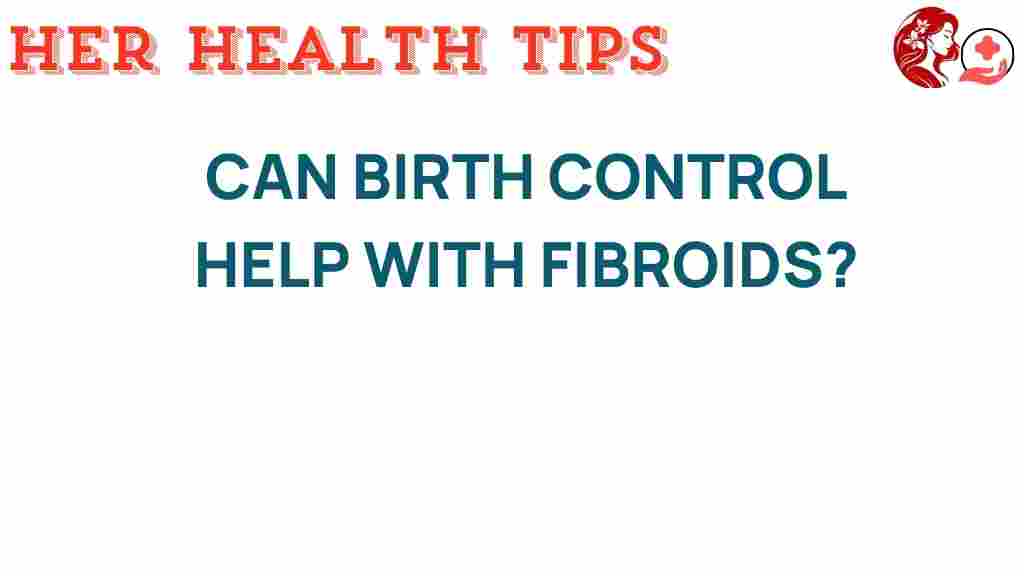Unraveling the Mystery: Can Birth Control Alleviate Fibroid Symptoms?
Fibroids are noncancerous growths of the uterus that can lead to various symptoms, including heavy menstrual bleeding, pelvic pain, and pressure symptoms. As an important issue in women’s health, many are searching for effective treatment options. One question that frequently arises is whether birth control can help alleviate the symptoms associated with fibroids. This article explores the relationship between birth control and fibroid symptoms, discussing hormonal treatments, pain relief, and the latest medical research.
Understanding Fibroids and Their Symptoms
Fibroids, also known as uterine leiomyomas, can vary in size and location within the uterus. They are classified into three main types based on their location:
- Intramural fibroids: Found within the uterine wall.
- Subserosal fibroids: Located on the outer surface of the uterus.
- Submucosal fibroids: Positioned just beneath the uterine lining.
The symptoms of fibroids can significantly impact a woman’s reproductive health and quality of life. Common symptoms include:
- Heavy menstrual bleeding
- Prolonged menstrual periods
- Pelvic pain or pressure
- Frequent urination
- Difficulty emptying the bladder
- Constipation
- Backache or leg pains
The Role of Birth Control in Managing Fibroid Symptoms
Hormonal treatments, including birth control, are often considered for managing fibroid symptoms. The rationale behind using hormonal birth control lies in its ability to regulate the menstrual cycle and reduce heavy bleeding.
How Birth Control Works
Birth control methods can be divided into two main categories:
- Combination hormonal contraceptives: These contain both estrogen and progestin. They work by suppressing ovulation, stabilizing the hormonal fluctuations that can contribute to heavy bleeding and pain.
- Progestin-only contraceptives: These methods, including the mini-pill, hormonal IUDs, or implants, help to thin the uterine lining and reduce menstrual flow.
By stabilizing hormone levels, these contraceptives may provide the following benefits for women suffering from fibroids:
- Reduced menstrual bleeding and cramping
- Decreased pelvic pain and pressure
- Minimized risk of anemia due to heavy bleeding
Medical Research on Birth Control and Fibroids
Numerous studies have investigated the effectiveness of hormonal treatment options, including birth control, for alleviating fibroid symptoms. Research indicates that:
- Women using combination hormonal contraceptives report lower levels of menstrual pain and reduced bleeding.
- Progestin-only methods are effective in decreasing bleeding and providing pain relief for some women.
- Long-term use of hormonal IUDs has been associated with a significant reduction in fibroid symptoms.
For example, a study published in the Journal of Women’s Health found that women treated with hormonal birth control experienced fewer fibroid-related symptoms compared to those who did not receive hormonal treatment.
Choosing the Right Option
When considering birth control as a treatment option for fibroids, it is crucial to consult with a healthcare provider. They can help determine which method is best suited for your specific situation based on:
- Your medical history
- The severity of your symptoms
- Your reproductive plans (e.g., desire to conceive in the future)
Step-by-Step Process to Implement Birth Control for Fibroid Symptoms
If you’re considering birth control as a means to manage fibroid symptoms, follow these steps:
- Consult a healthcare provider: Schedule an appointment to discuss your symptoms and treatment options.
- Discuss medical history: Be prepared to share your medical history, including any previous treatments for fibroids or other reproductive issues.
- Evaluate options: Your provider may recommend combination hormonal contraceptives or progestin-only options based on your individual needs.
- Monitor symptoms: After starting birth control, keep a symptom diary to track changes in your menstrual cycle, pain levels, and overall well-being.
- Follow-up visits: Schedule regular follow-ups with your provider to assess the effectiveness of the treatment and make any necessary adjustments.
Troubleshooting Common Issues
While many women find relief from fibroid symptoms using birth control, some may experience side effects or find that their symptoms persist. Here are some troubleshooting tips:
- Side effects: Common side effects of hormonal birth control include nausea, weight gain, and mood changes. If these become bothersome, consult your healthcare provider for alternatives.
- Persistent symptoms: If you continue to experience significant symptoms, consider discussing additional treatment options, such as non-hormonal medications or procedures to manage fibroids.
- Regular check-ins: Keep communication open with your provider to adjust your treatment plan as needed.
Conclusion: The Importance of Informed Choices in Women’s Health
In conclusion, birth control can be a viable option for alleviating the symptoms of fibroids in many women. By regulating the menstrual cycle and reducing heavy bleeding, hormonal treatments can improve quality of life and overall reproductive health. However, it is essential to consult with a healthcare provider to determine the most appropriate treatment approach based on individual circumstances.
As medical research continues to evolve, more options for managing fibroids may become available, enhancing women’s health and well-being. For those looking for further information on fibroids and their treatment, visit ACOG for comprehensive resources.
This article is in the category Reproductive and created by HerHealthTips Team
